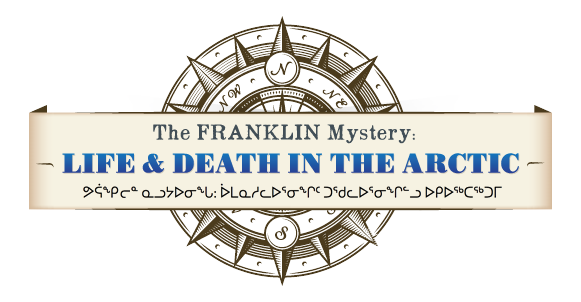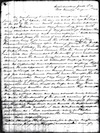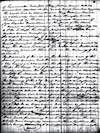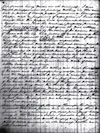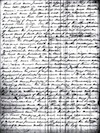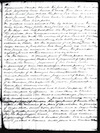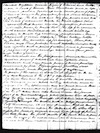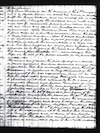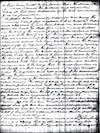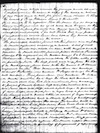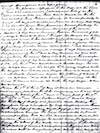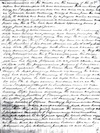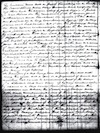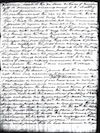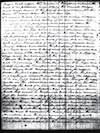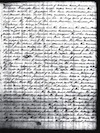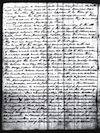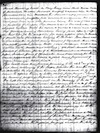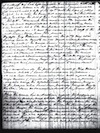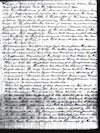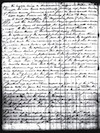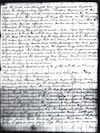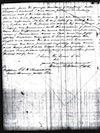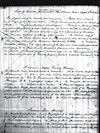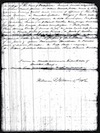Lieut. Hobson reports finding the Cairn and the Bodies (1 August 1859)
Arctic Searching Yacht Fox
Port Kennedy August 1st 1859.
Sir,
As my having travelled in company with you from the 2nd of April (the day on which we left the ship) to the 28th of the second month when our parties separated at Cape Victoria renders my furnishing you with any detailed account of my proceedings between these dates superfluous and unnecessary. I will commence my report from the time of our separation. My orders being to go around the North end of King Williams Island.
[...]
At 9-10 AM a large cairn was seen, a stonework that appeared [to] me that it was no Esquimaux encampment. I therefore ordered the tent to be pitched that we might search it at our leisure. Our first proceeding was to tear down the cairn which was carefully removed stone by stone.
The stones being carried to a sufficient distance for search being made in its vicinity. I was much disappointed at finding nothing in the cairn but a piece of blank paper folded in a triangular shape, and a fragment of rope yarn. I had little doubt that this paper had contained some information and that the writing (possibly pencil) had been effaced by exposure, it was utterly unprotected from the weather except by the stones of the cairn. Many of those at the top had fallen off and among them lay the fragments of two bottles in which papers may very probably have been deposited. The paper found was about two feet down from the top of the cairn as it stood when we found it, originally it could not have been up [more] than 8 feet high and was 9 feet in diameter at its base. The lower tiers of stones were very heavy and its construction must have been a work of some little labour and time.
After satisfying myself that nothing was buried underneath of the cairn and the compasses being useful in pointing out the magnetic North, I caused a circular trench to be dug at the distance of ten feet from the centre of the cairn. Where the nature of the ground would permit its being done. This trench was made about five feet broad but in many places the ground was so hard frozen that the pickaxe would make little impression and we could not put down more than a foot from the surface. We also dug under the cairn without success.-
Some scraps of canvass showing through the snow. Revisited these tent places, and on searching them we found many evidence of a visit from a party belonging to the Erebus or Terror. I selected a few relics which seemed best worth bringing away the greater part of what remains is old canvass, clothes and other rubbish. Three tents were found left apparently as they had been last slept in except that the poles were with drawn under the fallen tents, bear skins and blanket coverlets were left spread out, to all appearance probably as their last occupants had used them. A quantity of small articles were found in and about the tents. In the smallest of the three (which I supposed to have been an officers tent) a packet of needles, fragments of a small red ensign, a good deal of that, two eye pieces of small telescopes and fragments of the stockings, mitts, with [illegible] on the others. Inside the sleeping gear the remains of blankets frocks sox and common cloth trousers, mitts, stockings, with also a large bank of twine, a good deal of old clothing was strewn about the place.
The tents were pitched on a coast shingle ridge directly in front of the cairn. The nearest being about 9 feet down from it. Near them were three fire places about where we found several brimstone matches (some of them had been used), a quantity of ptarmigan feathers, some [illegible] meat [illegible], the jaw of a fox, and some very small fragments of partially consumed wood. I think that a small party must have been encamped here for some time, it may probably have been an observatory or a whaling station. The tents were very small and would not have accommodated more than ten or twelve persons. They were so rotten and frozen that I could not measure them but judged of their size from the spaces they occupied. For whaling purpose this station may have been established. I have little doubt it was lately abandoned and would think that the party must have been returning to their ship, under no other circumstance can I imagine that people would leave their tents, sleeping gear and cooking apparatus. Food seems to have been scarce with them, not a scrap of wood was found about the place save the very heavy stone of a marine's water bottle and the half consumed scraps about the fire place. The tents also had probably been burned to cook their corn meal pike heads from which the poles had been removed were found near the tents and I suppose the pieces had been their tent poles.
We worked until about 6 PM by which time the men were tired. Very little was found in the latter part of the day. At half past five on the following morning the search was recommenced and continued until half past ten with the interval of an hour at such a time, finding we were doing [at] best little good. I now ordered a march, at the distance of 150 yards from the large cairn a few stones had been piled up but nothing was found in, under, or round them.
[...]
Round and in the fire places several brimstone matches some of which had been lighted, some charcoal and very small pieces of wood partially consumed by fire. Ptarmigan feathers, salt, [illegible] bones and the jaw bone of a fox. The position of the cairn is 69˚ 63' at long. 98˚ W, a very short distance to the S.W. of Cape Felix-
[...]
Two hours travelling on the morning of the 6th brought us to a small cairn in which we found a pickaxe with the halve broken and an empty tea or coffee cannister. I brought the pickaxe away with me and left the cannister piling a few stones round it. An hour was spent in fruitless search for documents. After marching for three and a half to four miles in a southern direction from this place a large cairn was seen, close to which we pitched our tent at 11-15 AM. A great quantity of gear was strewn about the cairn which is a large one and had been built as we learned from a paper found alongside it by the crews of the Terror and Erebus when they landed after abandoning their ships, on the site of the pillar erected by Sir James Ross in 1828.
The cairn was of course the first object of our search, a small cylinder was soon discovered among some loosed stones that had evidently fallen from the top, it contained a brief statement of the movements of the last expedition, from it we learned that the ships after ascending Wellington Channel to Latitude 77˚ had returned by the west side of Cornwallis Island and passed their first winter at Beechy [sic] Island that they were last on the 12th September 1846 in Lat. 70˚ 05' at Long. 98˚ 23' W. [illegible] their ships on the 22d of April in 1848 - five leagues to the N.W. and landed at this place on the 26th- the survivors 105 in number were under the command of Captain Crozier and were to march on the following day for Back's Fish River. Sir John Franklin died on the 11th of June 1847 and the total loss of the expedition up to the date of their landing had been 9 officers and 15 men, it was found here stated that the paper had been found by Lieut. Irving under a cairn 4 miles to the North supposed to have been built by Sir James Ross (the same place in which I found the pickaxe and cannister) where it had been deposited by the late commander Gore in June 1847.
This paper when originally deposited was merely the running tide paper supplied to Her Majesty's ships and appeared to have been filled in and soldered down on board the ship, there is an evident mistake in the dates of the winter passed at Beechy [sic] Island which is found to be that of 46-47. The information respecting the abandonment of the ships and the line of their intended retreat had been written round the margin apparently by Captain Fitzjames, the writing agreeing with his signature. The paper is counter signed by Captain Crozier the words "and start tomorrow for Great Fish River" appear to be added by him. The writing of the note and the weak tremulous hand in which both that and his signature are written inclined me to the belief that he must have been in ill health on that early period. I of course brought away the original and left a copy of the document from the numerous articles that were [illegible] about in the vicinity of the cairn. I selected many interesting relics among the chief of which is a small dip circle, a small pillar sextant with Frederick Hornby RN engraved on it, a boats medicine chest and the cross piece and ring from the top of a mahogany gun case on which is engraved C.H. Osmer RN.
It appears to me that in landing at this place an excise of rations which had been brought from the ships took place and all that was considered superfluous deposited as here we found a vast quantity of clothing, 4 sets of heavy boats coppers, pickaxes, shovels - fragments of [illegible] stores etc.
I remained at the cairn until 11 AM of the 7th, when having satisfied myself that no other documents were to be found, and searched the vicinity as well as the deep coating of snow which covered the ground would admit. I deposited in the cairn a copy of the record, a notice of my visit and a note for you. And I tried to trace the coast of King William Island to the South.
It is much to be regretted that the snow as deep and heavy on the ground as if it were mid-winter, as there may well be, and probably are many relics here which have escaped our search. I do not think that any papers of importance could have been left or they would certainly have been noticed in the record.
The principle articles found at this place are as follows:
A small cylinder enclosing a record. 4 sets of boats copper, small dip circle in case, with magnet and 2 needles, a small double framed pillar sextant Frederick Hornby RN engraved on it, makers names E and E Emanuel, Portsmouth – small medicine chest, the bottles either greatly or partially full. The cross plate and ring from a mahogany gun case with the name C.H. Osmer engraved on it. Three marine canteens, one marked 88 compy W. Heather, one marked W. Hedges 89 compy, the third not marked. Three [illegible] one marked W. Aitken (or Mack), another No. 15 Mess. The third not marked. A small [illegible] that had contained gun wadding - 2 pieces of small hollow loop rod (like curtain rod), an iron shod with staff about 4 feet long – a quantity of iron loops, iron work from a large boat, a powder cannister turned into a water bottle, a corner of large canvas tent, three pickaxe and a shovel, a pair of waterproof leggings, an oar sawn down the centre with a blanket nailed to its flat side, three boat lock or [illegible] stones, a very large quantity of old clothing, principally being amongst which a stocking marked W. Orren was found. Another have the initials W.S., several strips of copper, a nine inch flask (stopped), two joints of a cleaning rod for a gun, two small copper spindles (probably 1st round), a quantity of fragments of rope canvass, spun yarn and rope yarn.
From the position assigned to the ships at the time of their abandonment I concluded that if, as the Lord intended us, there was a wreck on the Western coast of King William Island, it would probably be found at no great distance from us, as any ships drifting to the south from that position would probably be [illegible] up by the [illegible] shoulder of the land.
[...]
A wolf also had followed us on the 19th accompanied the sledge and gave much trouble as the dogs when they got in his track followed it at great speed, and it took all the persuasive powers of Christian’s whips to convince them to turn their heads the right way – he kept playing around us the whole day but was far too knowing to trust himself within reach of a rifle, he left us at night when we encamped. At one PM a large cairn was seen, which at the time I supposed might be Simpson’s cairn at Cape Herschel. I had not been able to get sights since leaving Ross’s cairn. Searching the cairn we found in it many feathers of ptarmigan, and snow owls. The latter quite fresh in it vicinity – We found many circles of stones marking Esquimaux summer tent places... The cairn itself which I suppose must be of Esquimaux construction did not appear to be of great age (the lower stones only mere moss grown) nor could it have been a cache as there was no considerable hollow space by whoever or for whatever purpose it was built.
[...]
We started from the islands about noon of the 22d the 57th day of our absence. The weather was increasingly bad but with the assistance of a strong SE wind could our sail be made about 9 miles. During the afternoon on the 23d the wind remaining fair and fresh we made a long journey, the sail helping the dogs amazingly. On the 24th, the trench of the sound taking us far off shore, I sent Louis and Edwards to walk the coast line (I was too lame to be able to do it myself). At three PM seeing Louis giving us chase, I turned to meet him and found that he had discovered a large boat upon the beach, I therefore ordered the tent to be pitched, and taking the small sledge and dogs around to the place leaving orders for the men to follow when the tent was up.
Approaching the spot I found a large boat entirely intended [illegible] about which nothing of her was visible.
[...]
She appeared to be in good repair but has a hole through the upper [illegible] on the starboard side about 12 feet from the stern, probably the mark of a bear. She appeared to have been lightened in every possible way. All iron and wood work that could be dispensed with had been removed but she rested on a sledge of great weight and strength. There were some markings on her stern but I could not decipher them.
[...]
Much gear was found in the boat in the stern, at right aft stood two double barrelled guns one on its side, both had one round discharged, the other loaded and capped. They stood on their buts [sic] resting against the upper rail. One of the chronometers, the three watches, most of the silver forks and spoons and all the ammunition found, were in the stern ship, a few pieces of silver were picked up in the fore part of the boat. In the stern sheets across the after board on the port side was a human jaw bone of great size, other bones of corresponding magnitude lay near. The leg bones were more forward on the starboard side. The man appeared to have been lying transversely across the boat with his head under the after [illegible] at the time of his death, part of a bear skin and pieces of blanketing were found about him. Also a large quantity of remains of clothing. These latter were so frozen together that they had to be dug out with the pickaxe and were consequently torn to pieces. I cannot say what clothing he wore. The small bones of the hands and feet remained in the mitts and stockings, the mess of clothing that lay about the bones must have belonged to several men. A chronometer bearing the name of Parkinson and Frodsham N was found near his remains and much in the position it would have been had he worn it in the waistband of his trousers in a noted pocket, from this I think it likely that the deceased may have been an officer, but I cannot pretend to say that there was anything else to lead to that conclusion...
[...]
The boat head when found was pointing to the North-East as was that of the sledge she had been dragged upon. She leaned a good deal to starboard and had been partially lifted from the [illegible] cut for her reception in the chocks. I did not observe that she was in any way secured to the sledge.
The length of the sledge was about 23 feet and its width about nine feet. The runnings were of three inch oak, reduced at the top to two inches, 8 inches deep and heavily shod with iron. There were five oak cross bars of great weight and 5 fir chocks for the boat to rest on. These were neatly leathered. The whole was very strongly latched and fastened. The drag ropes which still remained fast were of three inch whale line and had the Chatham mark. The broad dimensions are – length over all 28 feet extreme beam 7 feet 6 inches, depth 2 feet 6 inches.
The principal articles found in her are as follows- six paddles, about 60 fathoms of lead line, two double barrelled guns, a considerable quantity of powder that several double charges of that tied up in the fingers of kid gloves, two chronometers, three pocket watches, 11 dinner forks, 11 dinner spoons, and 4 tea spoons (bearing the initials of officers belonging to both the Terror and Erebus), several seaman knives, a great many [illegible], 5 shot glasses, several small religious books, a copy of the Vicar of Wakefield, a small Bible with many marginal notes, remains of three cakes of ships chocolate a small lead purse, a Victoria sixpence, a shoemaker's box with, tools, bristles, [illegible] with several small lots of tobacco, a small pair of gloves.
[...]
This boats head was found pointing to the N.E.t as if she had been returning to the ships, whether this was the case or whether she had been turned by accident, or by her crew to afford them a better shelter from the wind, I have no means of judging. Her position is lat 69˚ - 09' and Long. 99˚ - 28' W.
We left our encampment on the morning of the 26th retracing our steps towards Ross Cairn, at 11 AM of the 28th we found in a small cairn at the southern extreme of Backs Bay. Another of Commander Gore's records it was simply a tide paper like the first but was secured down and had not apparently been opened – it bore no date except May 1847. This paper like the former one was signed by Graham Gore (Lieutenant) and Chas. F. Des Voeux S. Mate, and had the discrepancy as to the dates of the winter passed at Beechy [sic] Island.
[...]
We left King William's Island on the 28th of May after having been a month on its most inhospitable coast. In no part of the world have I ever experienced such severe conditions of bad weather, from the 8th, the day we left Cape Franklin to this date.
[...]
Of animals we saw only bears and foxes. There seem to be a good many of both. The latter are very tame, on several occasions we had one within arm’s length of different members of the party – one was killed by the harnessed dogs after playing round them for some time. There is not the slightest chance of a party subsisting by hunting on this shore. We saw no traces of deer or musk oxen. The only birds seen were a few willow grouse and some snow buntings; in speaking of animals, I should have mentioned lemmings, many of which were seen, and one wolf that followed our sledges for a considerable distance.
[...]
The notes and papers found by us are already in your possession. I add to my letter a list of these... as to the places at which they were found. I found my provisions (with the exception of fuel) more than sufficient we could not use our full allowance of Pemmican, Bread or Pork. And my petty officers somehow managed to have surplus tea sugar and cream. This we used on our homeward journey. We were fortunate in getting drift wood and Bears fat which helped our fuel greatly – we must have picked up one way and another quite twenty days fuel.
I have the honour to be
Sir
your very obedient servant
William R. Hobson, Lieut. RN
List of Articles brought from the Cairn near Cape Felix
The fragments of a small red ensign, Metal lids, screw and hinge of a powder case. Brass ornaments from a marine. A few patent cartridges. Part of a pair of steel framed spectacles glass replaced by wood with a slit for the eye. A parcel containing 6 or 8 packets of needles. A small copper cooking apparatus. A small keg of powder. 2 pie heads and a fragment of iron work of a pickaxe. The heavy stone of a marine water bottle, a worked [illegible] glove, 2 eye pieces of small telescopes, probably belonging to a sextant, several brimstone matches, a piece of blank paper folded up in a triangular form, a smaller piece of blank paper folded like a common note.
From Point Victory
A small tin record case and record. A 6 inch dip circle Robinson I–22. a six inch double framed pillared sextant by E & E Emmanuel Portsmouth, with Frederick Hornby - RN engraved upon it. A small medicine chest. A carpenters rule. 2 small copper spindles, circular brass plate and handle broken out of a mahogany gun case. C. H. Osmer engraved on it, the field glasses and German silver end of a small telescope. 2 joints of a cleaning rod. A tea or coffee cannister.
From the Bark
A small lead purse, one of the glasses of a telescope, a small tin cylinder, a small bag containing percussion caps of three different sizes. A pair of blue spectacles with wire sides (in a tin case). A small pemmican tin marked E. Two double guns, a small bible with marginal notes, a copy of the Vicar of Wakefield, several small religious books. 11 – silver desert [sic] spoons. 11 - silver desert [sic] forks, and 4 tea spoons, bearing crests and initials of officers of the Terror and Erebus, a musket bullet, charges of shot tied in the fingers of kid gloves, a silk huswife, Two pairs of spectacles made out of stout leather, wire gauge substituted for glass. Two small pocket compasses. 1 – shot flask. Three spring hooks of sword [illegible]. a gold lace cap [illegible] and a small piece of gold twist. A pack of leather spectacles with [illegible]. 2 small stoppered bottles (full). 3 glasses of spectacles, remains of a pair of silver mounted spectacles. A small piece of silver for caps. A trap shot charges. 2 – silver pocket chronometers, three silver watches.
From a small cairn on the south side of Backs Bay
A small tin record case with a record.
William R Hobson, Lieut. RN

